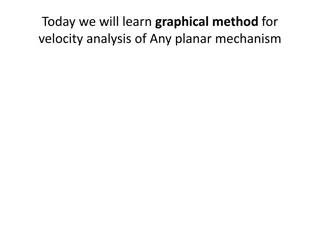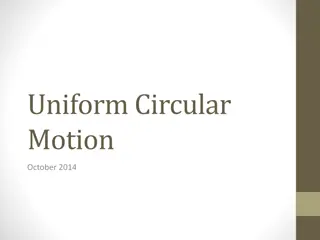Understanding Velocity: The Key to Motion
Velocity is the speed and direction at which an object moves, indicating both its position and rapidity. It is crucial for measuring the rate of change of an object's position over time and differentiates from speed as a vector quantity. This comprehensive guide delves into the concepts of velocity, including instantaneous velocity, vector nature, units of measurement, and the distinction between speed and velocity.
Download Presentation

Please find below an Image/Link to download the presentation.
The content on the website is provided AS IS for your information and personal use only. It may not be sold, licensed, or shared on other websites without obtaining consent from the author. Download presentation by click this link. If you encounter any issues during the download, it is possible that the publisher has removed the file from their server.
E N D
Presentation Transcript
Definition: Velocity is the speed at which something moves in one direction. e.g. The speed of a car traveling north on a major freeway and the speed a rocket launching into space can both be measured using velocity. Velocity is the prime indicator of the position as well as the rapidity of the object. Velocity can be defined as the displacement of the object in unit time. The velocity of an object is the rate of change of its position with respect to a frame of reference, and is a function of time. Velocity is equivalent to a specification of an object's speed and direction of motion (e.g. 60 km/h to the north).
The instantaneous velocity of an object is the limit of the average velocity as the elapsed time approaches zero, or the derivative of x with respect to t: v(t)=ddtx(t). v ( t ) = d d t x ( t ) . Like average velocity, instantaneous velocity is a vector with dimension of length per time.
Velocity (v) is a vector quantity that measures displacement (or change in position, ( s) over the change in time ( t), represented by the equation v = s / t
Quantity : Vector is a vector quantity. Units: The SI unit for velocity is Meter per second (m? ?)
Speed, being a scalar quantity, is the rate at which an object covers distance. On the other hand, velocity is a vector quantity; it is direction-aware. Velocity is the rate at which the position changes. The average velocity is the displacement or position change (a vector quantity) per time ratio. Therefore, speed and velocity are not same.
Speed is a scalar, velocity is a vector. We care because it gives us more information. In three dimensional space velocity is expressed with three numbers. Velocity includes information about direction as well as speed (magnitude of velocity). So we need velocity to specify the direction which speed cannot.
Velocity comes with direction, it indicates a speed at a direction. If velocity becomes negative, it is that speed in the opposite direction.
Zero velocity is essentially no movement. What this means is that your change in position from time a to time b is zero. This happens when you throw an object to the sky. Just before it falls, when there is no force moving it upwards, it will remain motionless and its velocity will be zero.
a car moving. a ball being dropped. the earth moving around the sun.
A body is said to have uniform velocity if it covers equal distance in equal intervals of time in a particular direction. i.e. s/t = constant
When a truck travels in equal distances in equal intervals of time then we say that the body has got a uniform velocity. In the above example a truck is traveling at 5 miles in all the positions at A, B, and C and all in the intervals of 5 minutes each.
When an object covers unequal distances in equal intervals of time in a specified direction, or if the direction of motion changes, it is said to be moving with a non-uniform or variable velocity. e.g., revolving fan at a constant speed has variable velocity.
UNIFORM VELOCITY: when an object is moving in a straight line, without any acceleration. No change in speed or direction is experienced. CONSTANT VELOCITY: when the speed of an object has not changed even though the object may have experienced a change in direction (zero acceleration).
The definition of acceleration is: that is defined as the rate at which an object changes its velocity. An object is accelerating if it is changing its velocity. Acceleration is the rate of change of velocity. Usually, acceleration means the speed is changing, but not always. When an object moves in a circular path at a constant speed, it is still accelerating, because the direction of its velocity is changing.
Any change in the velocity of an object results in an acceleration: o increasing speed (what people usually mean when they say acceleration) o decreasing speed (also called deceleration or retardation ), o or changing direction (called centripetal acceleration ).
Acceleration (a) is the change in velocity (v) over the change in time ( t), represented by the equation: a = v/ t. This allows you to measure how fast velocity changes in meters per second squared (m/s^2).
Acceleration is a vector quantity The SI unit of acceleration is the metre per second squared (m s 2); or "meter per second per second", as the velocity in meters per second changes by the acceleration value, every second.
Velocity is the rate of change of position with respect to time, whereas acceleration is the rate of change of velocity. Both are vector quantities (and so also have a specified direction), but the units of velocity are meters per second while the units of acceleration are meters per second squared. Therefore, velocity and acceleration are not same.
Whenever you accelerate in one direction, you feel a gravity-like sensation pulling you in the opposite direction. That sensation is sometimes called a "fictitious force," despite the fact that it isn't a force at all. The feeling of acceleration is really just your inertia acting to impede your acceleration.
When the car slows down. When you fall off a bridge. The car turning at the corner. o All are the examples of acceleration because the direction is changing. The quicker one turns, the greater the acceleration.
Yes a body can have zero velocity and can still accelerate simultaneously .So, at the highest point for a body thrown upwards, velocity is zero and acceleration is equal to g (9.8 ms^-2) in downward direction.
Velocity is a vector with speed and direction, any change is that is acceleration. The earth is accelerating because it's direction is changing. Yet it's speed around the sun remains more or less constant, changing slightly as earth moves from its perihelion to aphelion.
Earth moves very fast. It spins (rotates) at a speed of about 1,000 miles (1600 kilometers) per hour and orbits around the Sun at a speed of about 67,000 miles (107,000 kilometers) per hour. We do not feel any of this motion because these speeds are constant.
An object in constant acceleration has a linear velocity vs. time graph; that is, the slope of the graph is constant. Initial velocity is independent of the slope of the graph; that is, the acceleration. An object thrown downward still accelerates after release at the same rate as an object that is dropped.
If the velocity is constant however, the acceleration is zero (because the velocity isn't changing over time). Although at an instant in time it is possible to have zero velocity whilst accelerating. For example, if you drop an object at the instant you release it has zero velocity but it is accelerating.
Yes, a body can have positive velocity and negative acceleration at the same time. For example when a lift goes upwards from 4th to 8th floor considering base as origin and get stopped then velocity is positive while acceleration is negative.
Freefall is a special case of motion with constant acceleration, because acceleration due to gravity is always constant and downward. This is true even when an object is thrown upward or has zero velocity. Acceleration from gravity is always constant and downward, but the direction and magnitude of velocity change.
Yes, an object that was set in motion in the past by some force, but that is no longer being acted on by a net force, is moving but with zero acceleration, i.e. it is moving at constant velocity.























